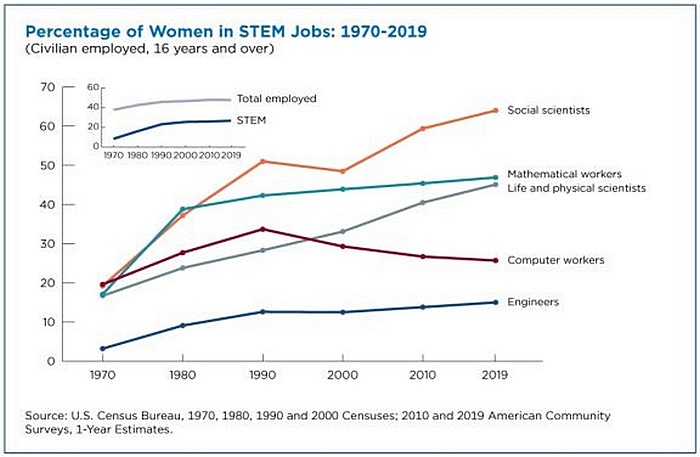A September 2021 Korn Ferry survey revealed 55% of professionals believe employee turnover will only increase in 2022, with 30% citing ‘re-evaluation of priorities amid the pandemic’ as a primary reason for leaving.
Further, 43% believe this is hurting the business and that already 74% are experiencing a shortage of skills and capabilities today needed for the future. With 45% conceding the difficulty of finding qualified talent/skills, 37% are taking the upskilling/reskilling of current employees as one way to alleviate the challenge.
KornFerry forecasts that by 2030, there could be more than 85 million jobs going unfilled resulting in US$8.5 trillion in unrealised value.
Women under-represented in STEM
The US Department of Commerce’s Economics and Statistics Administration noted that women hold just 24% of STEM (Science, Technology, Engineering, Mathematics) positions, with specific fields like engineering having a considerably greater gender disparity. Also, while the proportion of women employed in computer professions is higher than it was in 1970, the trend is going downward from 1990 to 2019.


Srilakshmi Sanikommu, senior director, DevOps (Software Engineering) at Procter & Gamble (P&G) Asia Pacific, Middle East & Africa, recalled that when she joined Procter & Gamble (P&G) in India in 2006, she was one of only five female employees among the 400 technicians and managers at the plant.
Her first role required her to lead the Information Systems department at the plant. “It was initially quite daunting, but thankfully because of the strong equality culture at P&G, the gender lens soon faded. Over time, working alongside the technicians at the plant, I was able to implement solutions that improved overall plant productivity,” recalled Sanikommu.
Karen Ko, director for marketing, Asia Pacific & Japan at SailPoint, acknowledged that STEM has been crowded with men in the early years. She acknowledged that working in the STEM industry, roles were typically in marketing, customer services, HR and sales.
Looking back, Belinda Jurisic, senior director channel, cloud and service provider strategy & management at Veeam Software, said that during the first ten years in the tech industry, it was a rare sight to see another woman in the meeting room.
“I often found myself being singled out for role opportunities because I was female. Since then, there has been a gradual yet significant shift in gender representation in the STEM industry. Many companies now put gender representation on their agenda, leading to an increased demand for female employees in the STEM industry,” she added.
Management roles – the new frontier?
According to the UNESCO Institute for Statistics noted that globally women remain under-represented in senior management and decision-making levels.
Asked why this is so, P&G’s Sanikommu cited two main barriers preventing more women in STEM management positions: The first is that there is a gap in the number of female STEM graduates entering the workforce.
“There is a need to shift mindsets and improve awareness of jobs for the future even from a young age, focusing on the confidence and skills needed to pursue careers in STEM,” she suggested. “The second reason is that among those who do enter the workforce, fewer grow into senior management positions. She opined that representation of women in STEM fields drops by a third when making the jump from entry-level positions to middle management.”
“I believe the current lack of women in management positions in STEM is partially due to the pool of female talent with the right experience within the industry. Over the last few years, we have seen more women entering the STEM fields, so I anticipate more women rising through the rank in the upcoming years,” noted Jurisic.

Sanikommu also reasoned that “At that stage of life, there is an increase in family and professional responsibilities and as a result, there are competing priorities. In addition to this, the need for continuous upskilling makes it even more challenging from a time commitment standpoint.”
Koh agreed and added that the timing of management roles (career progression/promotion to a management role) may clash with the timing of having a family planning/having a child.
“And given the stereotype of the role in the family (father vs mother), a woman always tasks to be accountable for childcaring instead of a male. Hence, a woman may likely scarify the work/ career progress for the family,” she continued.
Sanikommu said P&G helps to overcome these barriers through the right policies and organisational culture, helping to ensure a level playing field for all managers, with the right support to succeed.
Encouraging more women in STEM
For Jurisic, gender diversity in the workplace provides a multiplicity of perspectives that can spark creativity and innovation.
“It also provides companies with the ability to serve their customers from all walks of life better – an inclusive workplace is an improved reflection of your customers. To encourage gender inclusivity, we should showcase more success stories of women in our industry which could lead to inspiring other females to do the same,” she added.

Ko suggests that companies be more risk-taking in their hiring decisions and embrace diverse backgrounds. She proposed that industry associations and companies organise more insight-sharing sessions/meetups, that focus on bringing women together can help inspire more women to pursue STEM. “I think the best source of encouragement is from women coming together to support each other,” she opined.
Like Ko, P&G’s Sanikommu believes that mentoring women pursuing STEM education will help prevent the drop-off seen before entering the workforce. She observed that many organisations are expanding and upskilling their technology functions as they embrace digital transformation. They are seeking experienced talent that can deliver both short and long-term results. This often leads to an imbalance in gender diversity as most experienced applicants are male.
For Sanikommu the answer is clear. “It is important to ensure a sufficient pipeline of female STEM leaders at all levels of an organization, with active mentorship and coaching for high potential women to ensure there is equality at senior management levels,” she voiced with certainty.
Advice for companies and leadership
Sanikommu acknowledges that technology is and will continue to play a major role in our lives. Many jobs now and in the foreseeable future will require STEM skills. In technology, this would be for roles such as cloud architects, data engineers, data scientists, AI engineers, and more.
“Women have an active role to play in shaping this future which is good for them and the world. Women pursuing STEM education must seek out and learn the latest technologies to continue being part of the conversation and staying relevant,” she added. “Learning in today’s world is much more accessible and convenient with numerous platforms available. The situation is ripe for women to seize the opportunity and inspire more and more women to pursue fulfilling careers in STEM fields.”
Veeam’s Jurisic says those aspiring to join the STEM fields should go for it. Many diverse roles require different skills and experience and can be very rewarding.
“Have the courage to start thinking about how you can start building your network early and put yourself outside your comfort zone to establish connections with people in the industry. Develop your network and focus on building your supporters and most importantly your mentors. They will encourage you to be confident in everything you do but also be your confidants when you need advice,” she advised.
SailPoint’s Ko highlighted that one component often overlooked is communication skills. This includes the ability to explain as well as ask the right questions to deeply understand what the true problem is that needs solving.
“It might mean that you must question or even contradict senior management in different business units, which requires political acumen as well as a lot of confidence. I think as women we have a leg up to not appear threatening, but at the same time, we might need to fight a bit harder to be taken seriously. Confidence is key!” she concluded.





